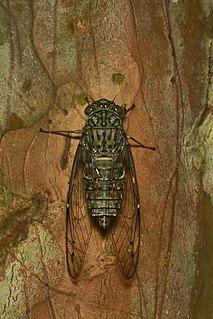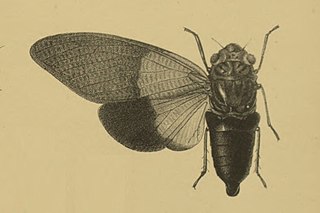
The cicadas are a superfamily, the Cicadoidea, of insects in the order Hemiptera. They are in the suborder Auchenorrhyncha, along with smaller jumping bugs such as leafhoppers and froghoppers. The superfamily is divided into two families, the Tettigarctidae, with two species in Australia, and the Cicadidae, with more than 3,000 species described from around the world; many species remain undescribed.

Hemiptera is an order of insects, commonly called true bugs, comprising over 80,000 species within groups such as the cicadas, aphids, planthoppers, leafhoppers, bed bugs, and shield bugs. They range in size from 1 mm (0.04 in) to around 15 cm (6 in), and share a common arrangement of sucking mouthparts. The name "true bugs" is often limited to the suborder Heteroptera. Many insects commonly known as "bugs", especially in American English, belong to other orders; for example, the lovebug is a fly and the May bug and ladybug are beetles.

Magicicada is the genus of the 13-year and 17-year periodical cicadas of eastern North America, consisting of seven species. Although they are sometimes called "locusts", this is a misnomer, as cicadas belong to the taxonomic order Hemiptera, suborder Auchenorrhyncha, while locusts are grasshoppers belonging to the order Orthoptera. Magicicada belongs to the cicada tribe Lamotialnini, a group of genera with representatives in Australia, Africa, and Asia, as well as the Americas.

Magicicada cassinii, sometimes called the 17-year cicada, Cassin's periodical cicada or the dwarf periodical cicada, is a species of periodical cicada. It is endemic to North America. It has a 17-year lifecycle but is otherwise indistinguishable from the 13-year periodical cicada Magicicada tredecassini. The two species are usually discussed together as "cassini periodical cicadas" or "cassini-type periodical cicadas." Unlike other periodical cicadas, cassini-type males may synchronize their courting behavior so that tens of thousands of males sing and fly in unison. The species was first described by Margaretta Morris. However, the specific name cassinii was in honour of John Cassin, an American ornithologist.

Magicicada septendecim, sometimes called the Pharaoh cicada or the 17-year locust, is native to Canada and the United States and is the largest and most northern species of periodical cicada with a 17-year lifecycle.

Thopha saccata, commonly known as the double drummer, is the largest Australian species of cicada and reputedly the loudest insect in the world. Documented by the Danish zoologist Johan Christian Fabricius in 1803, it was the first described and named cicada native to Australia. Its common name comes from the large dark red-brown sac-like pockets that the adult male has on each side of its abdomen—the "double drums"—that are used to amplify the sound it produces.

IvanRegen was a Slovenian biologist, best known for his studies in the field of bioacoustics.

The Slovenian Museum of Natural History is a Slovenian national museum with natural history, scientific, and educational contents. It is the oldest cultural and scientific Slovenian institution.

Matija Gogala is a Slovene entomologist, working mainly in the fields of insect bioacoustics, physiology and taxonomy.

Aleeta curvicosta is a species of cicada, one of Australia's most familiar insects. Native to the continent's eastern coastline, it was described in 1834 by Ernst Friedrich Germar. The floury baker is the only described species in the genus Aleeta.

Purana is a genus of cicadas from Southeast Asia. Its distribution includes Java, Sumatra, Borneo, the Philippines, peninsular Malaysia, Thailand, India, Indochina, China, and Japan. Only one species has been recorded east of the Wallace Line, Purana celebensis, from Sulawesi. In all species the male possess two pairs of dark ventral abdominal tubercles on third and fourth sternites. The male opercula are rather short and generally do not reach beyond the posterior pair of tubercles. Related genera that also possess abdominal tubercles are Leptopsaltria, Maua, Nabalua and Tanna which together with Purana are in the subtribe Leptopsaltriina of the tribe Cicadini.
Purana pryeri is a cicada species that occurs in Borneo where it is found in lowland areas.
Magicicada neotredecim is the most recently discovered species of periodical cicada. Like all Magicicada species, M. neotredecim has reddish eyes and wing veins and a black dorsal thorax. It has a 13-year life cycle but seems to be most closely related to the 17-year species Magicicada septendecim. Both species are distinguished by broad orange stripes on the abdomen and a unique high-pitched song said to resemble someone calling "weeeee-whoa" or "Pharaoh." They differ only in life cycle length.

The Cassini periodical cicadas are a pair of closely related species of periodical cicadas: Magicicada cassinii, having a 17-year lifecycle, and Magicicada tredecassini, a nearly identical species with a 13-year lifecycle.

Sphecius grandis, also called the western cicada killer, is a species of cicada killer wasp (Sphecius). The western species shares the same nesting biology as its fellow species, the eastern cicada killer. S. grandis, like all other species of the genus Sphecius, mainly provides cicadas for its offspring. It forms nest aggregations and mates and broods once in a year, in July and early August. The wasp is on average 3 cm (1 in) to 5 cm (2 in) in length and is amber-yellow with yellow rings on its abdomen.

Cicadetta montana is a species of Cicadetta found throughout Europe and in parts of Asia.

Cicadetta is a genus of generally small-bodied annual cicadas widespread across portions of the Palearctic, Oriental, and Ethiopian realms. In older scientific and taxonomic literature, this genus was popularly referred to as Melampsalta. These cicadas occur in a diverse spectrum of habitats, although most taxa are typically associated with weedy meadows and tallgrass prairie ecosystems. Several related species from North America were recently transferred to the genus Cicadettana.

Trengganua sibylla is a cicada species from Southeast Asia. The species is recorded from Terengganu, Jelebu and Temengor Forest Reserve in Peninsular Malaysia. Trengganua sibylla typically sings around high noon.

Maua is a genus of cicadas from Southeast Asia. The males possess two pairs of dark ventral abdominal tubercles on third and fourth sternites.

Purana tigrina is a species of cicada found in Southeast Asia. It was described from Malabar, South India. It is a common species in the Malayan Peninsula and on Bunguran Island in the South China Sea.















